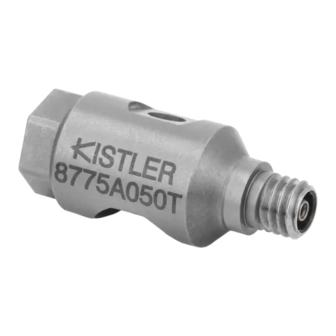Summarization of Contents
Important Information
Using this manual
Explains how to use the manual for technical details, installation, and operation.
For your safety
Provides essential safety regulations and notes for safe operation and maintaining product condition.
Precautions
Lists vital precautionary measures to ensure safe and reliable operation of the accelerometers.
Disposal of Electronic Equipment
Instructions on how to properly dispose of electronic equipment at the end of its life.
Nomenclature
Defines special designations and nomenclature used throughout the manual for Ceramic Shear sensors.
Product Description
Supplied Items
Lists the accessories supplied with accelerometers, such as studs or Petro Wax for mounting.
Technical Information and Functional Description
Piezoelectric Measurement Concept
Explains how piezoelectric accelerometers convert acceleration into an electric charge.
Ceramic Shear Background
Details the construction and working principle of the ceramic shear sensing assembly.
Low Impedance (IEPE) Output
Describes the IEPE output, its advantages for long cables, and signal characteristics.
Accessories
Details various accessories for mounting and connecting accelerometers.
Installation
General
Emphasizes careful installation for optimal frequency response, accuracy, and reliability.
Surface Preparation
Explains the importance of a clean, flat surface for accelerometer mounting and its impact on measurement.
Stud Mounting
Provides step-by-step guidelines and torque specifications for mounting accelerometers using studs.
Direct Adhesive Mounting
Recommends adhesives and details the process for direct adhesive mounting of sensors.
Adapter for Adhesive Mounting
Describes the use of clips and pads for adhesive mounting, including ground isolation.
Mounting with Wax
Discusses the use of Petro Wax as a mounting agent for lightweight sensors in temporary installations.
Magnetic Mounting
Explains magnetic mounting, its advantages, limitations, and safety precautions.
Summary of Mounting Methods
Summarizes various mounting methods with their accessories, advantages, disadvantages, and remarks.
Securing Cables
Illustrates correct and incorrect methods for securing cables to ensure proper strain relief and prevent fatigue.
Mass Loading Effects
Explains how accelerometer mass can affect the test article's response and provides a rule of thumb.
Operating Instructions
Powering
Details powering requirements, including using built-in sources and Kistler couplers.
Kistler Couplers
Mentions Kistler's line of power supply/couplers designed for compatibility with accelerometers.
Constant Current Power Supply/Coupler
Explains the function of the constant current source and its role in the accelerometer circuit.
Sensor Power-Up
Describes the voltage behavior at the coupler output during sensor power-up and settling time.
Overload Recovery
Explains how components behave during overload and the time required for recovery.
Supply Voltage Effects
Details acceptable fluctuations in supply voltage and their effect on sensitivity and noise.
Driving Long Cables
Discusses current requirements for driving long cables and their impact on frequency response.
Ground Loops
Identifies ground loops as a cause of noise and explains how they occur in the system.
Ground Isolation
Explains methods for achieving ground isolation to eliminate ground loops.
Frequency Response Limits
States that accelerometers have specified frequency limits due to mechanical and electrical design.
Frequency Response Definition and Standards
Defines frequency response and explains the standards used for its specification.
High Frequency Limitations
Discusses inherent mechanical limits and resonance effects on high-frequency response.
Low Frequency Limitations - Accelerometer
Explains electrical limitations at low frequencies and the high-pass filter behavior.
Low Frequency Limitations - Coupler and Read-out Instrumentation
Discusses how external components like couplers and instrumentation affect low-frequency response.
Technical Data
Recommended Data Sheets
Lists recommended data sheets for accessories, cables, and specific accelerometer types.
Calibration and Maintenance
Calibration
Describes the process of calibrating accelerometers by comparison with a standard.
Maintenance
Provides instructions for cleaning accelerometers and surfaces, and mentions factory repair.
Troubleshooting
Offers procedures for diagnosing and resolving common problems, including cable checks and bias monitoring.
Repairs
Advises on returning accelerometers for factory repair and the process for specific models.
Type 8778A500M14 Power & Signal Replacement Leads
Details the procedure and precautions for re-attaching or replacing power and signal leads.
Cleaning
Provides detailed instructions for cleaning accelerometers and removing adhesives.
Calibration
Repeats the definition of calibration and the back-to-back comparison method.
Storage and Transit Considerations
Safety Precautions
Lists precautions for storing and transporting the instrument to prevent damage.
Warranty
Kistler Instrument Standard Product Warranty
Refers the user to the standard warranty terms and conditions for sales and service.
Declaration of Conformity
EU Declaration of Conformity
Declares compliance with EU directives (EMC, ROHS) and applied harmonised standards.

















Need help?
Do you have a question about the 8778A Series and is the answer not in the manual?
Questions and answers